How to craft great page titles for SEO

Writing great page titles and SEO titles is essential for anyone doing SEO. Why? Because the title tag can be the first thing a user sees in the search results. It’s also one of the most important factors that Google uses to determine a page’s topic. Well-written titles are essential to SEO! This article covers why you need great page titles and SEO titles and how to create them.
Table of contents
- What is an SEO page title?
- What’s a post title? How is it different from an SEO title?
- What’s the purpose of an SEO title?
- Yoast SEO Premium uses generative AI to create titles
- What does the empty title check in Yoast SEO do?
- What does the SEO title width check in Yoast SEO do?
- What does the keyphrase in SEO title check in Yoast SEO do?
- How to use your keyphrase in the SEO title
- Should you add your brand to the SEO title?
- Optimizing titles after publication
- Note: Google won’t always use your SEO title
- Titles for social media
- Conclusion: Craft your (SEO) titles well!
Yoast SEO checks if you’ve used your keyphrase in the SEO title and whether your SEO title is a suitable width. It also checks if your post title is empty. Read about how those checks work, and how to use your keyphrase in the title.
What is an SEO page title?
Let’s start with the basics. If you look at the source of a page (right-click on the page, then choose View Page Source), you find a title in the head section. It looks like this:
<title>This is an example SEO title - Example.com</title>
This is the HTML title tag, also called the SEO title. When you look something up in a search engine, you get a list of results that appear as snippets. The part that looks like a headline is the SEO title. The SEO title usually contains the post title but can include other elements, such as the site name. Or even emojis!

In most cases, the SEO title is the first thing people see, even before they get on your site. In tabbed browsers, you will usually also see the SEO title in the page tab, as shown in the image below.

What’s a post title? How is it different from an SEO title?
The post title (also known as the headline) is your page’s main heading (H1). Like the title of any document, it gives readers an indication of the topic being discussed. First and foremost, your post title exists for users. It helps them to understand what you’re writing about and adds structure to your page.
To be clear, you should not confuse the SEO title with the post title. The SEO title appears in the search results; the post title is what users see after they click on the SEO title and get on the page itself.
What’s the purpose of an SEO title?
Your SEO title aims to make people click on it, visit your website, read your post, or buy your product. If your title is not good enough, people will ignore it and move on to other results. Essentially, there are two goals that you want to achieve with an SEO title:
- It must help you rank for a keyword;
- it must make the user want to click through to your page.
Google uses various signals when deciding your relevance for a specific keyword. Even when initially ranking well, your rankings might worsen if nobody clicks on your result. The opposite is also true. At first, you may be positioned lower in the search results. But, if your title gets people to click on it, Google will notice. Consequently, over time, your rankings may improve.
Also, as mentioned before, Google uses what has been specified as your SEO title as ranking input. So, it’s not just about those clicks; you also need to ensure that your title reflects the topic being discussed on your page and the keyword that you’re focusing on. The SEO title you use has a direct influence on your ranking.
Now that you know the importance of SEO titles, you’ll be pleased to know that Yoast SEO can help you craft them. In its SEO analysis, the plugin checks two crucial aspects of the SEO title: the width of your title and whether you use your keyword. The Premium plugin also includes a check to ensure your post title (H1 heading) isn’t empty.
Yoast SEO Premium uses generative AI to create titles
With Yoast SEO Premium’s AI title feature, you can effortlessly leverage the power of artificial intelligence to generate compelling and SEO-optimized page titles. This feature uses advanced machine learning techniques and algorithms to automatically craft engaging page titles that captivate your audience and fulfill search engine requirements.
By simplifying the process of title optimization, this tool ensures you adhere to the best SEO practices effectively. It boosts user experience and raises your website’s visibility, increasing high-quality, organic traffic. Take control of your SEO game with this exceptional feature, crafting standout page titles effortlessly.
In addition, if you use Yoast SEO Premium, you get various other AI features, like Yoast AI Optimize, that help you do the hard work.
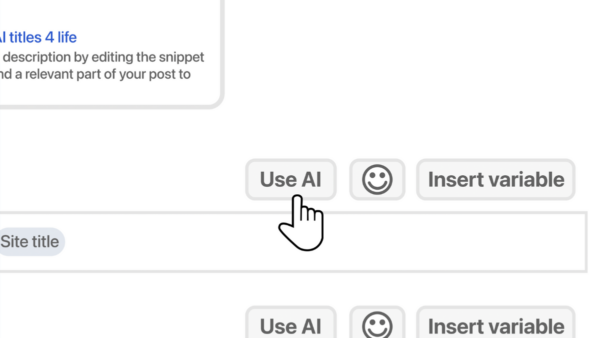
What does the empty title check in Yoast SEO do?
The empty title check in Yoast SEO Premium is self-explanatory: it checks whether you’ve filled in any text in your post’s ‘Title’ section. If you haven’t, you’ll see a red traffic light reminding you to add a title. Once this is filled in, the post title can be automatically added to the SEO title field using the ‘Title’ variable.
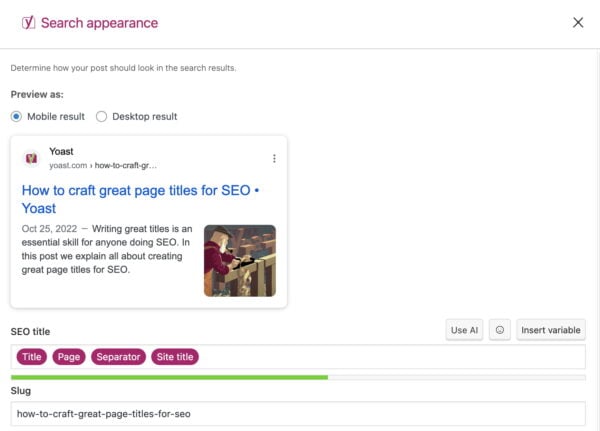
Note that your post title is output as an H1 heading. You should only use one H1 heading per page to avoid confusing search engines. Don’t worry; we’ve got a check for multiple H1 headings in Yoast SEO!
What does the SEO title width check in Yoast SEO do?
You will find this check in the SEO tab of the Yoast SEO sidebar or meta box. If you haven’t written an SEO title yet, this will remind you to do so. In addition, Yoast SEO checks the width of your SEO title. When it is too long, you will get a warning. We used to warn you if your SEO title was too short, but we’ve changed that since our Yoast 17.1 release. A title with an optimal width gets you a green traffic light in the analysis. Remember that we exclude the separator symbol and site title from the title width check. We don’t consider these when calculating the SEO title progress bar.
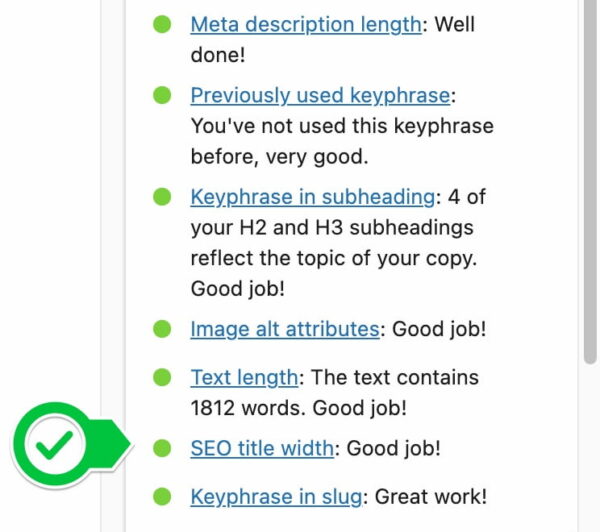
How to write an SEO title with an optimal width
If your SEO title doesn’t have the correct width, parts of it may be cut off in Google’s search results. The result may vary, depending on the device you’re using. That’s why you can also check how your SEO title will look in the mobile and desktop search results in the Search appearance section of Yoast SEO. The tool uses the mobile version as a default, but you can also switch to view it in the desktop version.
Here’s a desktop result:

And here’s the mobile result for the same URL:
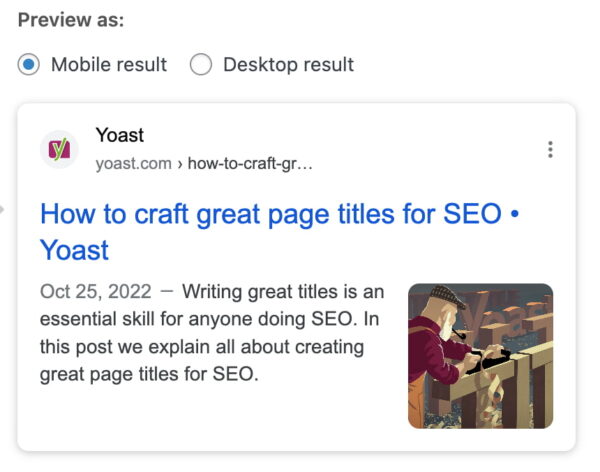
Width vs. length
Have you noticed that we talk about width rather than length? Why is that? Rather than using a character count, Google has a fixed width for the titles counted in pixels. While your title tags can be long, and Google doesn’t have a set limit on the number of characters you can use, there is a limit on what’s visible in the search results. If your SEO title is too wide, Google will cut it off visually. That might be different from what you want. Also, you should avoid wasting valuable space by making the title too short. Additionally, the SEO title often informs other title-like elements, such as the og:title , which also has display constraints.
Luckily, our Search appearance section can help you out! You can fill in your SEO title; our plugin will give you feedback immediately. The green line underneath the SEO title turns red when your title is too long. So keep an eye on that, and use the feedback to create great headlines.


What does the keyphrase in SEO title check in Yoast SEO do?
This check appears in the SEO tab of the Yoast SEO sidebar in WordPress and Shopify, and also in the meta box in WordPress. It checks if you’re using your keyphrase in the SEO title of your post or page. The plugin check for this is quite strict. Since Google uses the title to figure out your page’s topic, not having the focus keyphrase in the SEO title may harm your rankings. In addition, potential visitors are much more likely to click on a search result that matches what they were looking for. For the best results, you should try to add your keyphrase at the beginning of the SEO title.
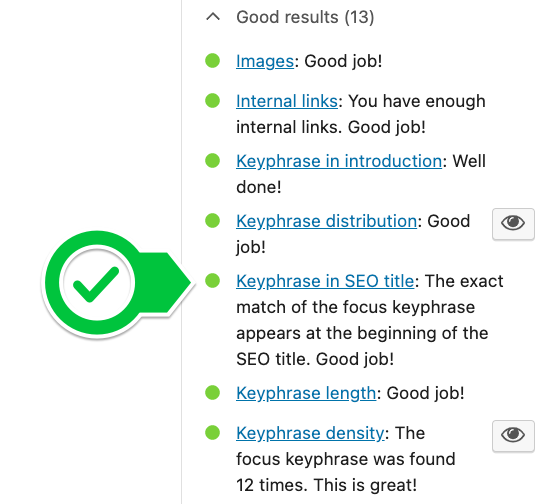
How to use your keyphrase in the SEO title
Sometimes, when optimizing for a high-competition keyword, everyone will have the keyword at the beginning of the SEO title. In that case, you can try making it stand out by putting one or two words before your focus keyword, thereby slightly “indenting” your result. In Yoast SEO, if you start your SEO title with “the”, “a”, “who” or another function word followed by your keyphrase, you’ll still get a green traffic light.
Other times, like when you have a very long keyphrase, adding the complete keyphrase at the beginning doesn’t make sense. If your SEO title looks weird with the keyphrase at the beginning, try to add as much of the keyphrase as early in the SEO title as possible. But always keep an eye on the natural flow and readability.
Want to learn how to write text that’s pleasant to read and optimized for search engines? Our SEO copywriting course can help you with that. You can access this course and our other SEO courses with Yoast SEO Premium. This also gives you access to extra features in the Yoast SEO plugin.
Go Premium and get free access to our SEO courses!
Learn how to write great content for SEO and unlock lots of features with Yoast SEO Premium.
Should you add your brand to the SEO title?
For quite some time, it was a fashion among some SEOs to leave the site name out of the SEO title. The idea was that the “density” of the title mattered, and the site name wouldn’t help with that. Don’t do this. If possible, your SEO title should have your brand in it, preferably in a recognizable way. If people search for a topic and see your brand several times, even if they don’t click on it the first time, they might click when they see you again on their next page of results.
But with the site names and favicon updates — be sure to fill in the site settings and upload a favicon! –, and general changes to the design of the snippets, your brand is better visible in the search results. Today, you’ll notice that Google hardly shows your brand name in the snippet’s title. However, Google often has a mind on its own when generating titles to change it for any given reason. And the design and function of the SERPs can change at any given moment, so we still advise you to add your brand to your titles.

Optimizing titles after publication
A while ago, while looking at our Google Search Analytics data for yoast.com, we noticed that, while we ranked well for [wordpress security], we weren’t getting a lot of traffic for it. We optimized our WordPress security article’s SEO title and meta description, increasing traffic by over 30%. These changes to the title were done around the same time as the update – indicated by the vertical line in the graph below:
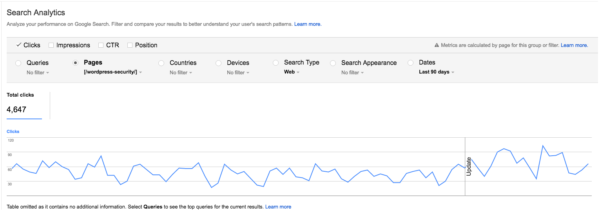
The change was pretty simple. Instead of the SEO title being:
WordPress Security • Yoast
We changed it to:
WordPress Security in a few easy steps! • Yoast
As you can see, this doesn’t necessarily improve this page’s rankings. From a keyword perspective, the title isn’t much better, but it is more enticing, and it did lead to many more clicks, which, of course, was the desired result.
Note: Google won’t always use your SEO title
Google sometimes shows a title different from the one you set in their search results. Before we get into that, it’s important to note that your page’s HTML title tag is still the most likely to be used in many cases.
Google Search currently uses the following sources to automatically determine title links:
- Content in
<title>elements - The main visual title, as shown on the page
- Heading elements, such as
<h1>elements - Content in
og:titlemetatags - Other content that’s large and prominent through the use of style treatments
- Other text contained on the page
- Anchor text on the page
- Text within links that point to the page
WebSitestructured data
Google tries to use only one title and won’t change it up for different search queries. And that they will use different elements on your page to decide on the title displayed in the search results. Elements include your title tag, headings, prominent text on the page, and even how you link internally to this page, as mentioned in the list above.
So what does this mean for you? The SEO title you set is still very likely to be used, and more importantly, your title helps you rank for a keyword. This doesn’t impact your page rankings. The title you give is what Google will look at when deciding how your page ranks. However, sometimes Google will show your brand name, and sometimes it won’t.
As with everything, keep an eye on how Google displays the titles of your most important pages! Please watch Google Search Console, spot-check your search results, and look for changes in your key pages’ click-through and bounce rates.
Titles for social media
What might be a good SEO title isn’t necessarily a good title for social media. In social media, keyword optimization is less important than creating a title that entices people to click. You often don’t need to include the brand name in the title. This is especially true for Facebook and X if you include some branding in your post image. Our social media appearance previews in Yoast SEO Premium and Yoast SEO for Shopify can help you.
If you’re using Yoast SEO, you can have a separate title for Facebook, X, and Google. Just enter the Google title in the Yoast SEO snippet editor. The Facebook and X titles can be entered in their respective fields on the social tab. If you don’t enter a specific X title, X will use the Facebook title instead.
Conclusion: Craft your (SEO) titles well!
In conclusion, the main point of this article is to encourage you to invest a little more time in writing good titles. It is worth it. Going back and optimizing some of your SEO titles after publication might also be worthwhile. This is especially true if you’re already ranking well but aren’t getting many clicks.
Read more: How to create the right meta description »

